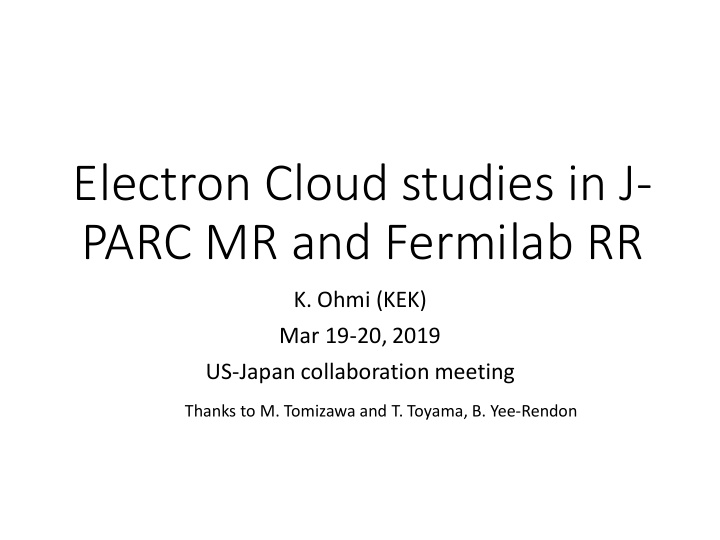



Electron Cloud studies in J- PARC MR and Fermilab RR K. Ohmi (KEK) Mar 19-20, 2019 US-Japan collaboration meeting Thanks to M. Tomizawa and T. Toyama, B. Yee-Rendon
Electron cloud effects in J-PARC • Seen only in Slow extraction mode. • Longitudinal microwave instability occurs simultaneously with the electron cloud signal. • Longitudinal emittance is enlarged to suppress the micro-wave instability. • The instability has not been seen in Fast extraction mode in spite of much higher intensity.
SX mode Beam intensity ~ 4 10 13 protons EC at the debunching process at the flat-top No EC P3+75ms P3 timing Fast CT Beam signal intensity P3+5ms P3+75ms Debunching With EC longitudinal single bunch Fast CT instability signal longitudinal couple bunch instability P3+5ms EC signal Beam spill One turn of the ring Coupled bunch instability occurs at the top With EC energy. Longitudinal dipole motion, dz/ds ≠ 0. Single bunch (MW) instability occurs at overlap on debunching. High frequency component of the bunch profile induces electron cloud.
° ° Electron cloud build up is triggered by longitudinal single bunch instability which is induced by longitudinal couple bunch instability. ° ° ° ° Electron current~80 m A/cm 2 . • • Electron production rate 0.25A/m. • Figure 4: The beam current signals for events with and without electron cloud in the time If Electrons stay 50ns in chamber, domain, top and bottom left, respectively. The corresponding Fourier transform plots are the line density is 7.5x10 10 /m. “ ” shown in right side in the same order. “ ” • Threshold line density is 10 8 /m. “ ” “ ” • Measured density is very high. “ ” “ ” “ “ ” ” “ ” “ ” “ ” “ ” “ ” “ “ ” ” “ ” “ ” “ ”
Sim imulation for or SX mod ode (d (deb ebunching) Simulation Frequency spectrum of the beam with the sinusoidal beam density modulation measured by the Fast CT 30 – 50 MHz EC appears ° ° “ Multipactor condition” may be satisfied “ ” “ ” “ ” “ ” “ ” “ ”
Electron frequency and instability threshold • Electron frequency bounded in proton beam potential • w e,x = w e,y =32MHz (2.8x10 13 ppp), 40 MHz (4.2x10 13 ppp) for s xy =7.5mm. • l p =averaged proton line density=1.8x10 10 -2.7x10 10 m -1 . • These frequencies are consistent with the electron amplification in the previous page. w e resonates with the frequency component (30-50MHz) of the bunch profile. • Threshold of the beam instability 2𝛿𝜕 𝑓 |𝜃 𝑞 |𝜏 𝑞 (𝜏 𝑦 + 𝜏 𝑧 )𝜏 𝑦,𝑧 = 7.6 × 10 7 𝑛 −1 𝜇 𝑓,𝑢ℎ = 3𝑑𝑅𝑠 𝑞 𝛾 𝑧
Why the instability is seen in SX mode • Beam intensity (ppp) • FX mode 3x10 14 >> SX mode 6x10 33 𝜇 𝑓,𝑢ℎ = 2𝛿𝜕 𝑓 |𝜃 𝑞 |𝜏 𝑞 (𝜏 𝑦 + 𝜏 𝑧 )𝜏 𝑦,𝑧 • Energy spread is similar? 3𝑑𝑅𝑠 𝑞 𝛾 𝑧 D p/p 0 Debunching 𝜏 𝑞 z Local momentum spread is much less than the total momentum spread M. Tomizawa
Effort of mitigation • Increase longitudinal emittance at the injection Injection at RF phase Phase offset [degree] Phase offset EC presence depends on Larger RF phase results longer bunch length the RF phase at MR injection before debunching. and the beam intensity / beam power
Electron cloud in Fermilab Recycler Parameters L=3300m, h=588, N bunch =500, N p/bunch =5x10 10 e x,rms =5.5x10 -8 m, < b >=40 m s z,rms =0.6m(0.3m), s d ,rms =0.03% L bsep =5.6m (1.87ns), l p =8.9x10 9 m -1 (line density). w e /2 p =344 MHz, w e s z /c=2.2 5cm 10cm
Combined bend • Electron motion in combined bend. • Integrate cyclotron motion using local magnetic field. • Runge-Kutta integration is slow for high field, high cyclotron freq. • w c =eB/m=2 p x 3.8x10 10 /s • w c s z /c=24.2 • Magnetic Mirror B 0 : B at initial position, 2 𝐶 0 = 𝑤 ⊥0 B m : B at mirror position 2 𝐶 𝑛 𝑤 0
Electron distribution B+Q B curved stripe Q
Studies done by S. Antipov, PRAB20, 044401 (2017) • Small amount of electrons trapped in combined bending magnets played important role for electron build up. • Experiments and simulation showed that electrons were swept by a bunch located at separated position from the bunch train. • Horizontal coupled bunch instability (caused by electron cloud) dominated.
What should we do? • J-PARC • Manipulate better longitudinal distribution. • Feed back the longitudinal coupled bunch instability. • Is the measured electron density reasonable? • Fermi-RR • How large is the Secondary emission rate? • Measure electron current. • Transverse coupled bunch instability has been observed. How is transverse single bunch instability? • Transverse Feed back damper?
Recommend
More recommend